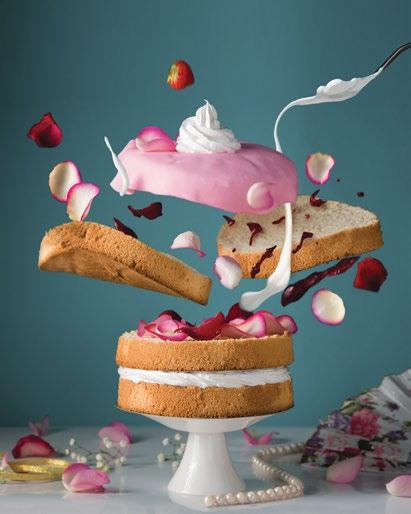
3 minute read
SIME DARBY
KNOW YOUR BAKING FATS
When it comes to baking, fat plays an important role in the structure, moistness and tenderness of baked goods. Fats provide an all important function of preventing the dough or cake batter from drying out. That is why, for example, baked goods with less fat content tend to turn out drier, tougher and lighter-colored. The question then is always, which fat is the best to use in baking applications. Well, it all depends on your end goal, all we can do is help you make an informed decision by highlighting our pros and cons for each choice.
Advertisement
BUTTER Butter is a well know fat made from dairy by churning milk solids (buterfat) from liquids (buttermilk), hence butter will contain fat and some water in it, unless its clarified of all its liquids then it will be called ghee.
Butter has a distinct natural flavour and colour that imparts on baked goods and gives cakes a creamier and more complex taste compared to cakes baked with margarine or shortening. Either than taste, butter also gives baked goods a soft and tender texture. This happens when butter fat coats flour, which then slows down the process of gluten formation creating a tenderer product.
When discussing butter one can never not mention the price, which tends to be on the hefty side. In the South African context there are many contributing factors to this, including the fact that as a country South Africa remains the net importer of butter. There has also been a rise in popularity of pro-butter diets and therefore higher demand, amongst other factors will push the prices higher.
MARGARINE Margarine is often produced as an economical substitute for butter. Manufacturers make margarine from plant-based oils, such as canola oil, palm fruit oil, and soybean oil. Just like butter and also according to regulation a margarine must have at least 80% fat for it to be considered a margarine, as anything less is considered a fat spread. Margarines are often flavoured to give a butter flavor to match its rival, and in most cases because the production of flavor can be controlled, margarine’s butter flavour is always consistent which may not be the case with butter as no two cows are the same, an therefore a possibility in variation of taste.
SHORTENING Shortening on the other hand is also made of pure vegetable fat and contains no water. For this reason, it tends to create baked goods that are softer than pastries or biscuits prepared with butter or margarines for example. Unlike butter and margarine, shortening is also usually flavor free and unsalted, and that would therefore affect the flavor profile of your baked goods. Vegetable shortening also has a higher melting point than butter, meaning it would still be hard in room temperature and this feature tends to leave a fatty mouth feel that may linger. This, coupled its water-free feature makes it perfect for making buttercreams that keep shape for long and can withstand warm and hot environments compared to buttercreams made from butter or margarine. Its colourant free profile also perfect for uncoloured or bright white icings.
Whilst this feature focused on the functional commonalities and differences of butter, margarine and shortening, the truth is there are many other features that one may also need to consider such as health, nutrition sustainability and scientific amongst many that contribute to the choice of fat in baking.

Bid farewell to collapsing and melting cakes because Kreemishort Premium Full Fat Shortening is no ordinary creaming margarine.


Your cake tiers are guaranteed stable buttercream layers that will support your cake layers and avoid total collapse. Its water-free, high fat ratio feature makes it perfect to create buttercreams that withstand warm and hot environments, while keeping shape.













